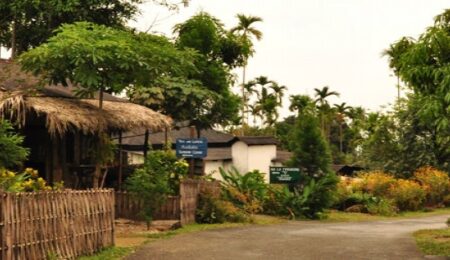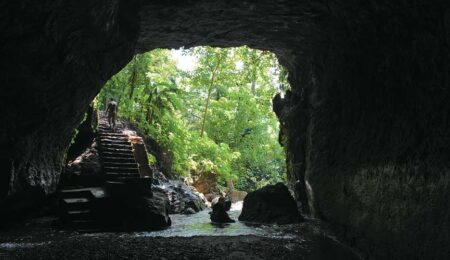 Hidden within a remote and untouched region lies a natural wonder that has captivated adventurers and researchers: the enigmatic Krem Chympe Cave. This cave system offers a fascinating glimpse into the Earth’s history with its intricate passageways, stunning geological formations, and rich biodiversity.
Hidden within a remote and untouched region lies a natural wonder that has captivated adventurers and researchers: the enigmatic Krem Chympe Cave. This cave system offers a fascinating glimpse into the Earth’s history with its intricate passageways, stunning geological formations, and rich biodiversity.
Located in northeastern Meghalaya in India, Krem Chympe Cave is part of a larger cave network known as the Jaintia Hills Cave System. This region is renowned for its extensive network of caves, some of which are among the longest and deepest in the world. Krem Chympe, meaning “Cave of Bats” in the local Khasi language, is one of the prominent caves in this complex.
One of the striking features of Krem Chympe Cave is its sheer size. It has a labyrinth of interconnected passages, chambers, and galleries stretching several kilometers. Explorers who have ventured into its depths describe it as an underground realm of awe-inspiring beauty and mystique. The cave boasts an awe-inspiring size and complexity, with a labyrinth of interconnected chambers, galleries, and tunnels waiting to be explored. Its vastness and intricacy have attracted speleologists and cave enthusiasts from around the world, drawn by the allure of uncharted territory and the promise of new discoveries.
Another one of the most remarkable aspects of Krem Chympe Cave is its stunning array of stalactite and stalagmite formations. Over thousands of years, mineral-rich water slowly drips from the cave’s ceiling, depositing calcium carbonate and other minerals that gradually build up these magnificent formations. As visitors venture deeper into the cave, they are treated to a mesmerizing display of delicate draperies, majestic columns, and intricate cascades illuminated by the soft glow of their torches.
 Beyond its geological wonders, Krem Chympe Cave is a thriving ecosystem hosting diverse flora and fauna. With their unique ability to navigate in the dark, bats dominate the cave’s airspace. Several species of bats can be found roosting in the cave, creating a mesmerizing sight as they soar through the passages. These winged creatures play a crucial ecological role, pollinating plants and dispersing seeds, ensuring the survival and diversity of the surrounding vegetation.
Beyond its geological wonders, Krem Chympe Cave is a thriving ecosystem hosting diverse flora and fauna. With their unique ability to navigate in the dark, bats dominate the cave’s airspace. Several species of bats can be found roosting in the cave, creating a mesmerizing sight as they soar through the passages. These winged creatures play a crucial ecological role, pollinating plants and dispersing seeds, ensuring the survival and diversity of the surrounding vegetation.
Exploring Krem Chympe Cave poses numerous challenges and demands a high level of expertise. The cave’s remote location and difficult terrain make it a formidable expedition for even the most seasoned spelunkers. The complex network of passages and the possibility of encountering treacherous underground rivers make it imperative for explorers to be well-prepared and equipped.
Scientific expeditions to Krem Chympe Cave have yielded valuable insights into the Earth’s history. Geologists and paleontologists have discovered fossilized remains of ancient marine life, suggesting that the cave system was once submerged underwater. These findings provide valuable clues about the geological changes that have shaped the region over millions of years.
Beyond its scientific significance, Krem Chympe Cave is culturally and spiritually important to the local communities. The indigenous Khasi people consider the cave sacred and believe it to be the dwelling place of benevolent spirits. Rituals and ceremonies are performed near the cave entrance during religious festivals, highlighting the deep connection between the cave and the region’s cultural heritage.
Preserving the delicate balance of Krem Chympe Cave is of paramount importance. The fragile ecosystems within the cave are susceptible to disturbances caused by human activities. Efforts are underway to promote responsible tourism and conservation practices that minimize the impact on the cave’s delicate ecosystem. It is crucial to balance promoting exploration and research while ensuring the long-term preservation of this natural wonder.
It is also a photographer’s paradise with stunning views and amazing rock formations. The cave is located in the East Khasi Hills and is one of the most popular tourist attractions in the state.
The cave is named after a local tribe called the Khasi people, who used to live in the area. The word ‘Krem’ means ‘cave’ in their language. The cave is also known as the ‘elephant cave’ because of the many elephant bones found in the area. The cave is a great place to explore and take photos. The views from the top of the cave are amazing, and the rock formations are interesting. There are also some great spots for bird watching.
In conclusion, Krem Chympe Cave is a testament to the Earth’s timeless beauty and mysteries. Its magnificent formations, diverse fauna, and cultural significance make it a remarkable destination for those passionate about adventure and exploration. As we delve deeper into the secrets of this subterranean realm, may we continue to appreciate and protect the wonders beneath the surface of our planet.





